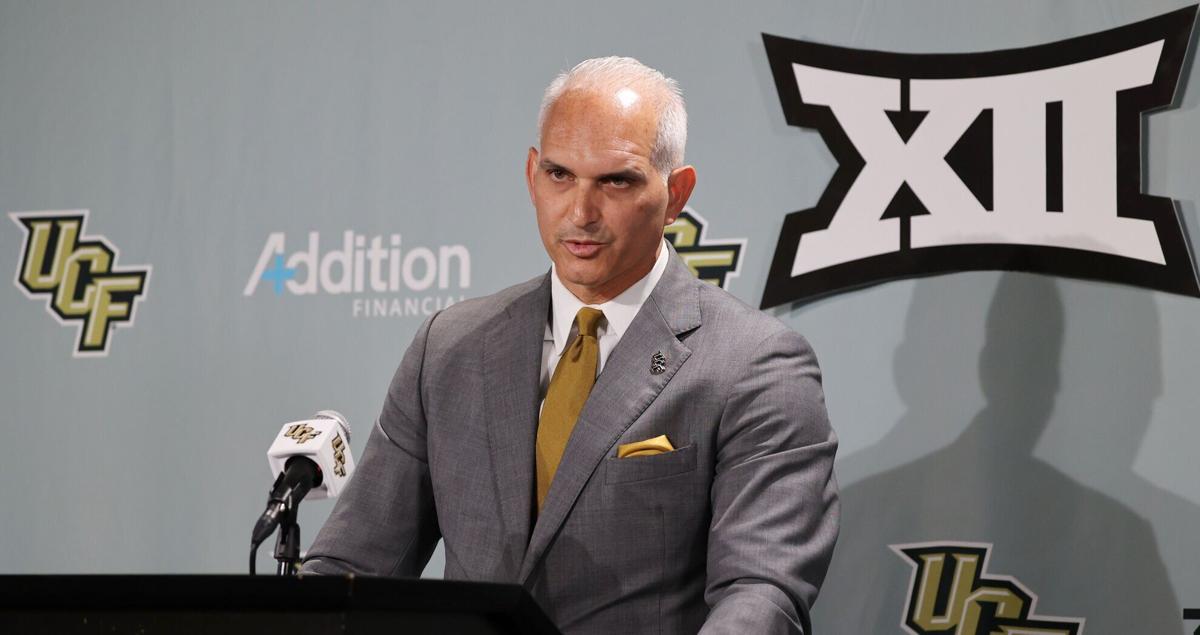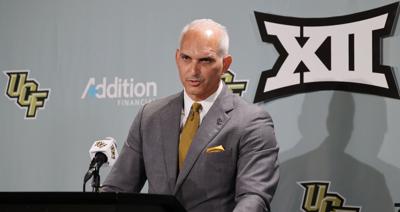ORLANDO, Fla. — Everywhere you look across the landscape of college sports, athletic directors are holed up in boardrooms and budget meetings, furrowing their brows over spreadsheets and taking a chainsaw to line items like movie villains in a slasher flick — desperately trying to figure out how they’re going to come up with an additional $20.5 million a year to pay their athletes.
Programs are bracing for staff cuts. Olympic sports are sweating their survival. Facility upgrades are being shelved or downsized.
The University of Kentucky’s athletics department expects to operate at a net loss of nearly $31 million over the next two fiscal years and is borrowing $141 million from the university’s general fund to offset the deficit.
The hoity-toity University of Michigan athletic department is receiving $15 million in support from the university’s general fund so it can balance its budget this year.
People are also reading…
And then there’s UCF … calm, calculating and oddly comfortable amid the chaos.
“We’re in a little better position because we’re getting some new money [from the Big 12] as opposed to some other programs that have a $20.5 million bill coming to their athletic department,” UCF athletic director Terry Mohajir says.
I would say UCF isn’t just in a little better position; it’s in a much better position.
Yes, UCF — the young, brash program often dismissed by traditionalists as a Johnny-come-lately — may actually be better equipped to navigate the beginning of the pay-for-play era than the so-called bluebloods.
Why? Because unlike Florida, Florida State, Miami and other marquee programs throughout the country that have long been dining at the wagyu-laden lobster-stuffed banquet table of TV riches, UCF has been living off the crumbs — and learning how to stretch every dollar like a Depression-era homemaker. Now, just as this new system demands schools pony up as much as $20.5 million annually to pay athletes, UCF is suddenly flush with new money, having joined the Big 12 and becoming eligible for a full share of TV revenue starting this year.
To put it plainly: While some schools will need to scramble, cut and beg to fund this new mandate, UCF will simply carve out its share from this fresh windfall of Big 12 media money.
Before moving to the Big 12, UCF’s annual TV revenue from the American Athletic Conference hovered around $9 million. Starting this year, UCF’s Big 12 revenue will spike to approximately $45 million annually — nearly a $36 million jump from the AAC. Even after setting aside the NCAA’s proposed $20.5 million for athlete payments, UCF still pockets $24.5 million. That’s a $15.5 million net increase in TV revenue from where the program was just two years ago.
Meanwhile, the established programs like Florida and Florida State already have baked their SEC and ACC TV money into their oversized athletic budgets. They’ve committed millions to coaching buyouts, bloated staffs and opulent facilities.
Now, they must find $20.5 million more per year — on top of what they’re already spending — to meet the athlete compensation requirements. Some — like Kentucky, Michigan and Washington — are borrowing while others may have to lean harder than ever on donors already fatigued by name-image-likeness (NIL) collectives.
But UCF? The Knights get to pay players with new money — and still come out ahead.
And maybe, too, UCF is better-equipped to navigate the current financial landscape because the Knights are accustomed to pinching pennies, turning dimes into dollars and digging into the couch cushions to stay competitive.
Consider their stadium. While many major programs have spent hundreds of millions on NFL-style cathedrals, UCF opened The Acrisure Bounce House in 2007 for roughly $55 million — a bargain at the time and an incredible steal by today’s standards. FSU would spend more than $55 million if it needed to buy out Mike Norvell’s contract after this season.
Or consider UCF’s indoor practice facility, completed in 2005. UCF was the first program in the state to build one, beating Florida and Florida State to the punch by nearly a decade. Again, it was constructed with resourcefulness, not extravagance.
UCF has always been a program that maximized efficiency and had to adapt and improvise out of necessity. And this is precisely the type of entrepreneurial spirit that the Knights and other programs will need to succeed in the era of revenue-sharing.
However, where UCF is at a massive disadvantage within the state and within its own conference is that the Knights don’t have nearly as many well-heeled boosters ready to supplement player salaries with exorbitant “NIL” deals. Even though conference commissioners and coaches say they will follow the new rules in regard to policing third-party (booster) NIL deals, color me skeptical.
It’s been reported by that Texas Tech — aided by free-spending billionaire booster Cody Campbell — currently has an athletic payroll of $55 million. When I made the statement to Mohajir that it “doesn’t seem believable” that some schools are suddenly going to tell their athletes that they have to take a pay cut, the UCF AD responded, “It doesn’t seem believable, but that’s what they’re going to have to do. There are a lot of provisions to guardrail cap circumvention … and the penalties are punitive.
“I know there are a lot of cynics,” Mohajir added, “but I feel pretty good about it [the new system]. I have to look at it from an optimist’s standpoint. I feel like we’re on the right track. Is it perfect? No. But at this particular time, we need progress over perfection.”
Progress over perfection isn’t just a Mohajir soundbite; you could say it’s a summary of UCF’s entire journey and how it has prepared the Knights for this new era.
You see, this isn’t just about money; it’s about mindset.
UCF was built on budget discipline, innovation and adaptability.
In this new world of college football, a case could be made that the Knights are no longer an afterthought; they’re a trendsetter.



















